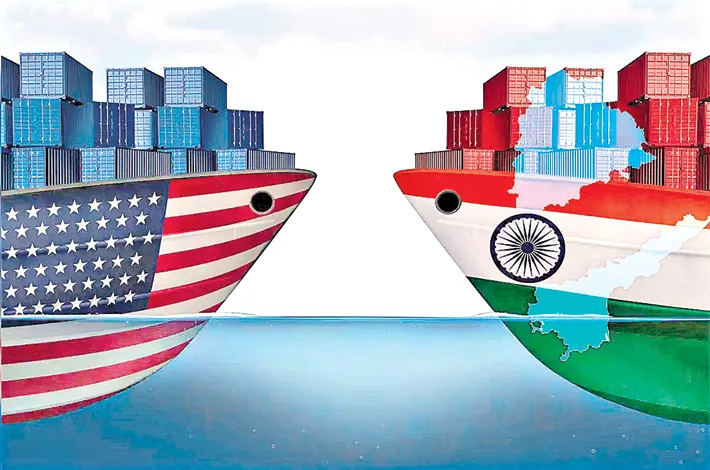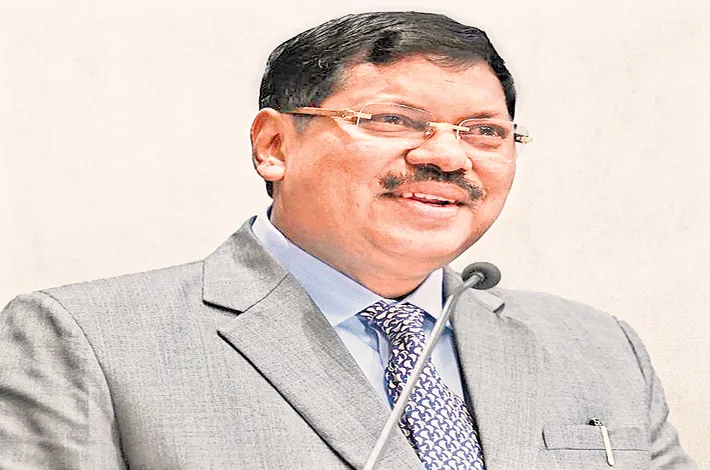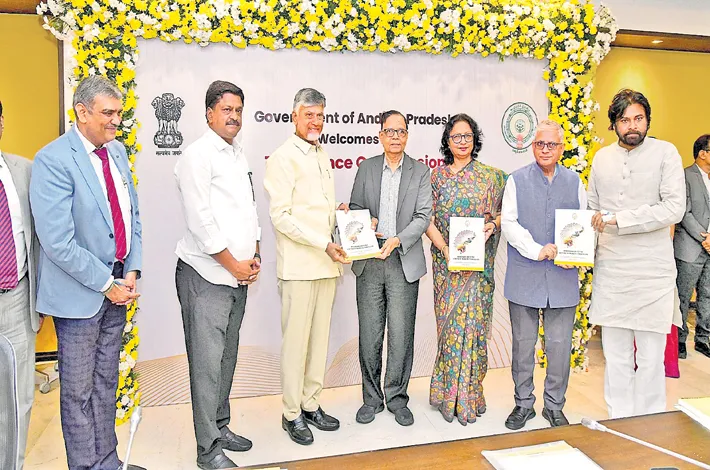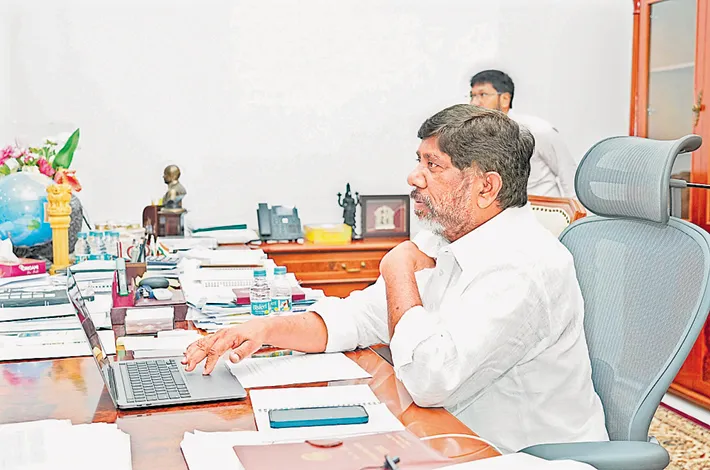Time for Telugu states to seize opportunities
13-04-2025 12:00:00 AM

vjm divakar I hyderabad
The US tariff hikes, announced by President Donald Trump in April 2025, have sent ripples through global trade, with reciprocal tariffs of up to 27% imposed on Indian goods effective April 9, 2025. While these measures pose challenges, they also open doors for Indian states like Andhra Pradesh and Telangana to capitalize on shifting trade dynamics.
By leveraging their economic strengths—Andhra Pradesh in aquaculture, textiles, and electronics, and Telangana in IT, pharmaceuticals, and manufacturing—both states can mitigate risks and position themselves as key players in a reconfigured global market. This analysis explores how these states can turn adversity into opportunity through strategic diversification, infrastructure upgrades, and proactive trade policies.
Andhra Pradesh: Turning Tariff Challenges into Trade Opportunities
Andhra Pradesh, a powerhouse in aquaculture, textiles, and emerging electronics manufacturing, faces direct impacts from the 26% US tariff on Indian goods. However, competitors like Vietnam (46%), Bangladesh (37%), and China (34%) face steeper duties, giving Andhra Pradesh a relative edge. The state can adopt a multi-pronged strategy to navigate this landscape.
1. Aquaculture: Diversifying markets and boosting resilience
Andhra Pradesh accounts for roughly 70% of India’s shrimp production, a sector supporting millions of livelihoods but now threatened by US tariffs. To counter this, the state can diversify export markets. China, with its retaliatory 84% tariffs on US goods starting April 10, 2025, presents a prime opportunity, as Indian shrimp could gain a competitive edge. Similarly, the EU, Japan, and South Korea show growing demand for seafood. By enhancing traceability and certifying antibiotic-free shrimp, Andhra Pradesh can meet stringent standards in these markets, opening new revenue streams.
Domestically, the state can promote shrimp consumption through marketing campaigns and value-added products like ready-to-cook seafood. The National Prawns Coordination Committee, recently formed under Chief Minister Chandrababu Naidu’s leadership, could spearhead these efforts. Additionally, subsidies or insurance for aqua-farmers can cushion short-term losses while new markets are developed, ensuring the sector’s long-term viability.
2. Textiles: Capturing market share
Andhra Pradesh’s textile hubs, known for cotton and synthetic fabrics, stand to benefit from India’s lower tariff burden compared to regional competitors. The state can ramp up production to capture a larger share of the US apparel market, where Indian goods remain relatively cheaper. Modernizing textile parks with advanced technology will enhance efficiency and align with US buyer standards, maintaining competitiveness despite tariffs.
The state should also support India’s bilateral trade negotiations with the US to secure tariff reductions, amplifying benefits for exporters. By investing in infrastructure and fostering innovation, Andhra Pradesh can solidify its position as a textile leader in a tariff-altered world.
3. Electronics and Manufacturing: Riding the Supply Chain Shift
With tariffs disrupting supply chains for China and Vietnam, Andhra Pradesh’s electronics manufacturing base in Tirupati and Visakhapatnam is well-positioned to attract investment. The state can offer incentives like tax breaks and streamlined land access to lure US firms diversifying away from higher-tariffed regions. Policies aligned with India’s Atmanirbhar Bharat initiative can amplify these efforts.
Focusing on niche segments, such as smartphone components and low-end chip packaging, allows Andhra Pradesh to fill gaps left by competitors. Simultaneously, expanding skill development programs will build a workforce equipped for high-tech manufacturing, ensuring long-term growth.
These steps can transform the state into a regional hub for electronics production.
4. Agriculture: Value Addition and Market Diversification
Beyond seafood, Andhra Pradesh exports rice, spices, and other agricultural products. While pharmaceuticals are exempt from US tariffs, other agri-sectors face challenges. The state can redirect rice and spice exports to tariff-light markets like the Middle East and ASEAN nations. Processing agricultural goods into high-margin products, such as packaged spices or organic foods, can offset tariff costs and boost profitability. Farmer support through subsidies will further stabilize the sector during this transition.
5. Infrastructure and Logistics: The Backbone of Trade
To seize these opportunities, Andhra Pradesh must address logistical bottlenecks. Modernizing ports like Visakhapatnam will reduce turnaround times and handle increased export volumes. Expanding cold storage and refrigerated transport will preserve the quality of seafood and perishables for distant markets. Digital trade platforms can connect exporters directly with global buyers, bypassing tariff-driven disruptions. These investments will enhance the state’s competitiveness and resilience.
6. Central Collaboration: Amplifying impact
Close collaboration with New Delhi is critical. Andhra Pradesh should advocate for shrimp and key exports to be excluded from US tariffs, emphasizing their role in US food security. Tapping into central export promotion schemes can provide financial aid and market access support. Aligning with India’s trade negotiators to prioritize the state’s sectors in US talks will further amplify its global reach.
Telangana: Leveraging IT and Pharma amid Trade Shifts
Telangana, with Hyderabad as a global IT and pharmaceutical hub, is uniquely positioned to benefit from the US tariff hikes, which primarily target goods rather than services. By focusing on its strengths and attracting new investments, the state can enhance its economic resilience.
1. IT and Services: An Untouched Advantage
Telangana’s IT sector, hosting giants like Microsoft and Google, remains unaffected by US tariffs. The government can encourage firms to expand US-focused operations, capitalizing on demand for software and digital solutions. This growth can offset any losses in goods-related exports, reinforcing Hyderabad’s status as a tech powerhouse.
2. Pharmaceuticals: Scaling up for the US market
Hyderabad produces nearly half of the US’s generic medicines, and pharmaceuticals’ exemption from tariffs is a major boon. Telangana can support companies to scale production and capture greater market share, especially as competitors face trade barriers. Investments in R&D and faster regulatory approvals will further strengthen this sector, positioning Telangana as a global pharma leader.
3. Manufacturing: Attracting relocation
The tariffs disrupt supply chains for countries like China and Thailand, creating opportunities for Telangana to attract manufacturers in electronics, machinery, and auto components. The state’s industrial parks and Telangana Industrial Policy can be marketed to firms seeking alternatives to tariff-hit regions. Incentives like tax breaks and improved infrastructure will make Telangana a compelling destination.
4. Domestic Production: Reducing import reliance
Higher US tariffs may dampen demand for certain exports, but Telangana can pivot to import substitution. Incentivizing local production of electronics, textiles, and processed foods—sectors impacted by tariffs—can meet domestic demand and reduce reliance on imports. India’s Production-Linked Incentive scheme can bolster these efforts, driving manufacturing growth.
5. Infrastructure and Energy: Supporting industry
To attract manufacturers, Telangana must ensure reliable power and logistics. Expanding renewable energy projects, such as solar and wind, will lower costs for industries. Upgrading transport links and ports will position the state as a gateway for exports to alternative markets, enhancing its trade competitiveness.
6. Trade advocacy: Shaping global deals
Telangana should collaborate with the central government to negotiate trade deals that mitigate tariff impacts. India’s talks to cut tariffs on US imports could open doors for Telangana’s industries, particularly IT and pharma, to access American markets with fewer barriers. The state’s proactive discussions with industry bodies, as noted by the IT and Industries Minister, signal a commitment to shaping favorable trade outcomes.
Challenges and the path forward
Both states face hurdles. Andhra Pradesh’s small-scale aqua-farmers and textile producers may struggle with higher export costs, while Telangana’s smaller manufacturers could face short-term disruptions. Targeted subsidies, skill development, and market access programs can help businesses adapt.
By acting swiftly, Andhra Pradesh can diversify its markets, modernize its industries, and strengthen its global trade position. Telangana, meanwhile, can leverage its IT and pharma dominance to attract investment and boost domestic production. Together, these states exemplify India’s potential to navigate global trade challenges with agility and foresight, turning the US tariff hikes into a catalyst for economic growth.








